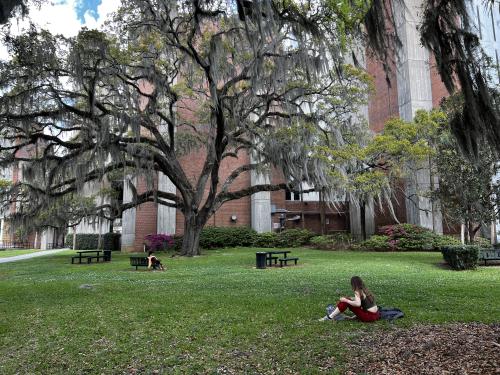Finding What Grounds Us
Samantha Malaver: Finding What Grounds Us
Outside Dittmer Chemistry Lab
By Adriana Nguyen
“Earthing? Have you heard of that?”
That’s what Samantha, a student here at Florida State, asked me when I encountered her in a small patch of green space just outside the Dittmer Chemistry Lab.
The answer was no.
Earthing, Samantha told me, is the practice of connecting your feet with the ground to discharge your stress and relax your nervous system. She said it has benefits for your body, emotions, your sleep schedule and more.
“I’m trying to connect with earth,” Samantha said. “So that’s why I come here.”
The key is to get your feet directly to the ground and connect with earth’s natural energy. It’s not just a holistic exercise, but earthing is something backed by studies involving the electrons found on earth’s surface. And anyway, it’s a great way to get outside—which even on its own is good for us.
At Florida State, there’s a lot of green space. Landis and Mina Jo Powell greens immediately come to mind, but the space where I met Samantha is a hidden gem. It’s without the size and popularity of other grassy areas on campus, and its location between two science labs means it’s far from the buzz of students. But for those looking for a moment to themselves, the space is a perfect hideaway.
That is, of course, until someone like me comes by asking to talk. As I near the end of my time at FSU, I find myself thinking about what makes us feel so connected to spaces like our college campuses. For many students, the outdoor areas at FSU represent a way to get connected with student life—whether that be by lying in a hammock, playing Spike Ball or, for Samantha, earthing in the sun.
In the transition to college and life in Tallahassee, these green spaces help us immerse ourselves in new environments and ground us amid changing experiences. When Samantha and I began chatting, she told me about her experience moving to Tallahassee from Venezuela.
“I met my boyfriend here.” Samantha said when asked about a favorite memory at FSU. “We’re both from Venezuela, but we actually met here.”
For students like Samantha, transitioning to a new country and culture is no easy feat. According to 2021 data from the Center for Global Engagement, only about five percent of students at Florida State University are from outside the U.S.
Samantha told me how nice it was to find people like her boyfriend—people with a shared life experience she could relate to. It helped make her transition a bit easier, but she mentioned keeping a small bubble has impacted her ability to get involved with the greater FSU community.
“I usually hang out with other Latin people—all my friends are Spanish speakers,” she said. “I think that’s the reason why I haven’t gotten out and seen other cultures and friends.”
I told Samantha that while I don’t have a shared experience of moving from out of the country, I also found it hard to insert myself in new experiences when I first came to college. Students at Florida State tend to be heavily involved—in their colleges, organizations, hobbies. In theory, this makes it easy for a student to find their own niche and make connections, but the tightknit nature of these involvements can make it more difficult to break into already-established groups.
“I’m trying to get more of that.” Samantha said about connecting with others that come from different backgrounds. “It’s actually my last term, so that’s why I want to work on that. I’m trying to hang out more with my classmates.”
What’s the big deal about connecting with the people around us anyway? Why are we always searching for community? Samantha told me it’s part of life as a whole.
“Your friends, your community. That’s an essential part of our lives—interact with each other, have fun and help others,” she said. “That’s fundamental.”
It’s not easy to confront the things that make us uncomfortable. That could be meeting new friends, moving to new countries or even walking barefoot on your college campus. But sometimes, confronting the things we’re scared of is what helps ground us to our own experiences as humans.
Sitting outside the Dittmer Chemistry Lab, our little patch of green grass seems like just that—a little patch of green grass. But, like many of the spaces we find ourselves in, the meaning of the green is more than just physical: it shows us the importance of seeking out connection and finding the space between us.
“Finding the Space Between Us” aims to discover the space where an attempt must be made to understand each other’s humanity. The hope is to bring light to what connects us to each other and the world around us by uncovering the meaning we give to the spaces we seek.


